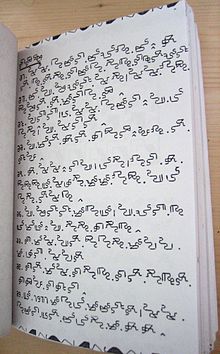Mandombe script
| Mandombe | |
|---|---|
 | |
| Script type | |
| Creator | Artificial script
|

Mandombe or Mandombé is a script proposed in 1978 in
A preliminary proposal has been made to include this script in the combined character encoding
was written in February 2016 by Andrij Rovenchak, Helma Pasch, Charles Riley, and Nandefo Robert Wazi.Structure
Mandombe has consonant letters and vowel letters which are combined into syllabic blocks, rather like hangul. All letters are based on a square S or 5 shape. The six vowels are distinguished by numerals added to the right of the 5-shape. The consonants fall into four 'groups', or shapes, which are distinguished by adding a short stroke to the 5-shape for three of the groups; and into four 'families', or orientations, which are distinguished by reflecting and rotating the letter shapes. The four families of consonants are attached to the same corner of the vowel, which is reflected or rotated to match the consonant, so that the consonant resides in a different corner of the syllabic block depending on its orientation. Unlike Pitman shorthand, which also distinguishes consonants by rotation, in Mandombe the groups and families do not form natural classes, apart from a fifth group of fricatives and affricates made by inverting one of the four basic groups. Vowel sequences and nasal vowels are created with diacritics, prenasalized consonants by prefixing n (the basic 5-shape), and consonant clusters by inserting a consonant between the two parts of the vowel (between the 5-shape and the additional strokes).
Vowels
Vowel letters are composed of two parts: the basic 5-shape of the Mandombe script plus a numeral, or—in the case of ü (/y/)—by modifying the basic u vowel letter. Vowel 1 is i, vowel 2 u, vowel 3 e, vowel 4 o, and vowel 5 a.
A
| Latin script | Mandombe | Composition | Diacritic |
|---|---|---|---|
| i | |||
| u | ? | ||
| e | |||
| o | |||
| a |
Consonants groups and families
There are four basic consonant shapes. Each shape (base character) can be reflected horizontally, vertically, or both to represent a different consonant; the four consonants thus formed are considered to be a group, and consonants reflected in the same way are considered to be a family. These consonants are combined with vowels, which are similarly reflected, to create syllables.
- Family 1
- The consonant with the basic orientation is attached to the lower left of the vowel
- Family 2
- The consonant-plus-vowel is reflected both horizontally and vertically (rotated 180°)
- Family 3
- The consonant-plus-vowel is reflected horizontally
- Family 4
- The consonant-plus-vowel is reflected vertically
Vowel diacritics are reflected along with the main vowel.
The use of geometric transformation is also present in Pitman shorthand and
Examples
| Consonant | Family 1 | Family 2 | Family 3 | Family 4 |
|---|---|---|---|---|
Group 1 |
na |
va |
sa |
ta |
Group 2 |
be |
de |
fe |
ge |
Group 3 |
ko |
mo |
lo |
po |
Group 4 |
wi |
ri |
zi |
yi |
| Mazita ma zindinga | shu |
dju |
tshu |
ju |
Complex characters
- (n) disconnected from the vowel. This always joins the consonant body, else certain signs could be read in more than one way.
- .
- If
 is placed between the two separable parts of the vowel glyph, it represents an intervening /r/.
is placed between the two separable parts of the vowel glyph, it represents an intervening /r/.
Examples of complex syllables
| Modification | Mandombe | Latin script |
|---|---|---|
| Vowel sequence | bie | |
| Diphthong/semivowel | mwa | |
| Nasal vowel or final nasal consonant | ken | |
| Prenasalized consonant | mbu | |
| Labial occlusion | gba | |
| Consonant clusters | pro | |
| plo |
Tones
| High tone | pó |
Digits
The digit for 1 resembles the
1–5 are also the shapes used for the vowels i u e o a.
| digit | Mandombe |
|---|---|
| 0 | |
| 1 | |
| 2 | |
| 3 | |
| 4 | |
| 5 | |
| 6 | |
| 7 | |
| 8 | |
| 9 |
Punctuation
A period is used as a word divider to separate words.
The punctuation corresponds to that of the Roman alphabet. A comma has the form of a short line, ![]() , a period a turned vee,
, a period a turned vee, ![]() , like the diacritic for o, and a colon and semicolon combinations of these (semicolon î, colon double
, like the diacritic for o, and a colon and semicolon combinations of these (semicolon î, colon double ![]() ). The exclamation mark is like a lambda, λ, and the question mark is like a turned Y, ⅄.
). The exclamation mark is like a lambda, λ, and the question mark is like a turned Y, ⅄.
See also
- Syllabary
- Writing systems of Africa
- Africa Alphabet
- African reference alphabet
External links
- L'écriture Mandombe (in French)
- Mandombe script
- Pasch describing the script, its origins, and its uses
References
- ^ Pasch, Helma. 2008. Competing scripts: the introduction of the Roman alphabet in Africa. International Journal of the Sociology of Language 191:65–109.
- ^ Unseth, Peter. 2011. Invention of Scripts in West Africa for Ethnic Revitalization. In The Success-Failure Continuum in Language and Ethnic Identity Efforts, ed. by Joshua A. Fishman and Ofelia García, pp. 23–32. New York: Oxford University Press.
- ^ Rovenchak, Andrij; Pasch, Helma; Riley, Charles; Wazi, Nandefo Robert (20 July 2015). "Preliminary proposal for encoding the Mandombe script in the SMP of the UCS Revised)" (PDF). Unicode. Retrieved 30 July 2015.
